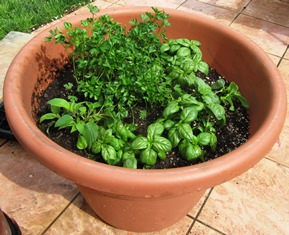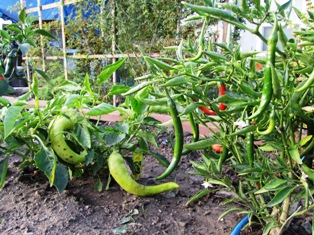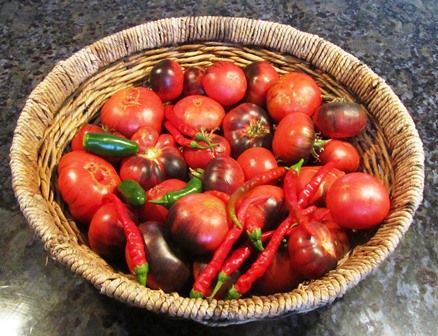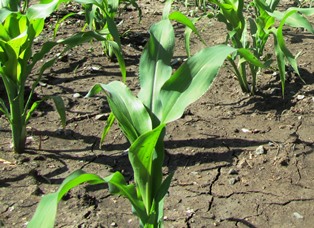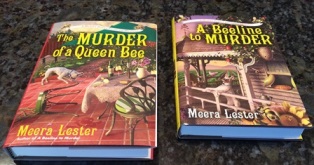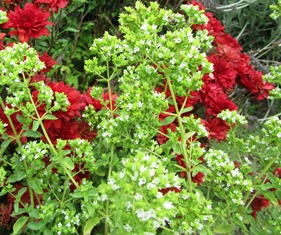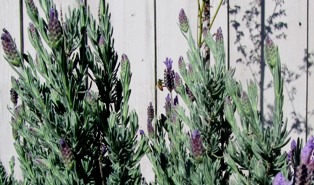Uses of Herbs in Your House and Garden
Herbs in abundance line the shelves of local garden centers now, and for good reason. Many of these versatile plants are hardy and adaptable and have myriad uses in a landscape.
Cooks, especially, appreciate access to culinary herbs near the kitchen. Grow cilantro, parsley, sage, tarragon, chives, basil, anise, dill, mint, and other desirable culinary herbs in boxes or giant pots on a kitchen patio. The location will make it easy to water and gather them.
Many herbs like chives, sage, and dill re-seed themselves, therefore, consider growing these in containers unless you have a designated space in your garden for them.
For shady areas in a landscape or garden, plant sweet woodruff, Borage, and chamomile. In areas that receive full sun, plant rosemary, mother-of-thyme, caraway-scented thyme, and woolly thyme. In areas that remain moist, plant angelica, mints, parsley, and sweet woodruff.
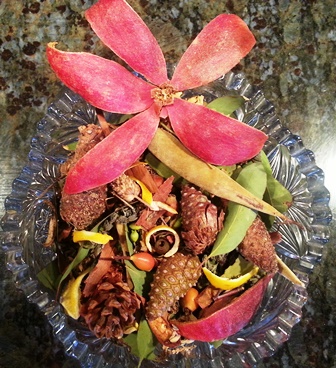
The leathery pomegranate peel takes center stage in this potpourri that utilizes herbs, seed pods, spices, and citrus peels
To grow herbs for potpourris and sachets to scent rooms in your home, cultivate costmary, English woodruff, and lemon-scented herbs like pelargonium and verbena. Also rose geranium and lavender add a lovely scent to mixtures of herbs for potpourri.
With so many different ways to use herbs to beautify a garden or patio and to flavor foods and scent a home, there’s no reason not to grow a few. Remember, herbs (like mint) can be dried for tea or crumbling over salads and you can collect herb seeds or propagate cuttings for next year’s herb garden.
Planting the Spring Garden
Winter brought us lots of rain and now the ground has warmed up and is ready to receive the heirloom seedlings of our favorite vegetables and herbs.
Tomatoes won’t set fruit until the nighttime temps hover around 55 degrees Fahrenheit, but I tucked in several seedlings of heirloom varieties (Bradley, Cherokee Purple, and Red Beefsteak). Victory Seeds offers a nice selection of open-pollinated, non GMO, rare heirloom seeds for a variety of tomatoes. See, http://www.victoryseeds.com/tomato.html
While I was digging, my neighbor’s bees decided to swarm. So I stopped gardening to check on my own bees. They’ve been humming like a truck engine, and there has been a lot of bee traffic. Concerned that they might swarm, I set aside my shovel and got out the swarm catcher, the lemon oil, and the hand pump sprayer. I positioned the swarm catcher in a tree across the yard, sprayed the tree with lemon oil, and went back to gardening.
I’ve readied a patch of ground for the sweet corn, squash, peppers, and beans. Also, in a large-size planter pot, I’ve tucked in flat Italian parsley, Italian oregano, dill, chives, and sweet basil. The patio pot will remain near the kitchen slider in full sun so I have culinary herbs at the ready when I need them.
The early sweet peas are taking off now and the garlic and onions I put in the garden last fall are about a foot high. The vegetables and herbs I plant now will provide me with plenty of nutritious offerings right up until late fall–one of the many reasons to plant a garden in spring.
Enjoy this blog? Check out my Henny Penny Farmette novels, available online and in traditional bookstores everywhere.
Heirloom Herbs for the Kitchen
The green stalks of the red and yellow onions I planted in late summer are now up about a foot in a raised bed. The garlic that I planted around the same time is also poking up. Having onions, garlic, and fresh culinary herbs available year-round is not impossible in the Bay Area’s mild climate, especially when they are grown in cold frames, protected areas, and raised beds.
Some will re-seed themselves in the growing beds or around your yards. We’ve got Greek oregano and chives growing all over the place. Some of my favorites herbs include basil, cilantro, chervil, chives, dill, fennel, lemon balm, lavender, oregano, mint, marjoram, rosemary, thyme, parsley, sage, and savory.
We also grow a few ornamental herbs such as borage, hyssop, and catnip (for our new kitty), tea herbs (chamomile and mint), and medicinal herbs (like echinacea).
Herbs are easy to grow. Their blooms will attract insects beneficial to the garden. Butterflies and hummingbirds are also attracted. And herbs don’t need much–light, and porous soil, warmth, and decent drainage. For a light feeding of the herbs, we make chicken poop tea. With so many varieties of herbs available, why not tuck a few in your garden or in containers in a protected but sunny and warm area of your patio to enjoy in your culinary creations?
Garlic–A Staple of Any Kitchen Garden
No proper kitchen garden would be without a section for onions (whether spring green onions, chives, or bulb onions) or garlic. Both kitchen staples are easy to grow. In several raised beds measuring four feet by six feet, I’ve planted garlic amidst a few jalapeno pepper plants. Garlic benefits other plants in the garden as well.
BEST TIME FOR PLANTING
In spring, after all danger of frost has passed, plant garlic cloves. Or, plant in late fall when you might be planting other types of bulbs. Some European gardeners swear that garlic must be planted on the shortest day of the year, the winter solstice.
I planted my garlic in late February/early March, long before my tomatoes, eggplant, pumpkin, and squash (the heat lovers) went in. The green garlic tops shoot out of the soil quickly and grow fast.
HOW TO PLANT GARLIC
Plant each clove from a bulb upright in soil roughly one-inch deep. Space the cloves four-inches apart. The growing site must receive full sun. Give the garlic a good watering each week. Garlic is a beneficial companion plant in the garden because of allicin (a property that acts as a fungicide and pesticide), especially when planted near lettuce and cabbage where it will deter aphids.
HOW TO HARVEST AND STORE GARLIC
When the tall green shoots of the garlic become dry and turn brown, it’s time to harvest the garlic bulbs. After you’ve pulled the bulbs out, shake off the dirt (never wash) and then hang the bulbs in a dark, dry place. Then when the bulbs are completely dry, you can braid the paper-dry tops to hang the garlic in the kitchen for easy access.
Herbs to Flatter Vegetables, Flavor Meat, and Finesse Fertility

If you have limited space, use taller herbs like this lavender in your landscape and gr0w smaller plants like mint in pots
Herb gardens have always held a fascination for me. One of the many reasons I love growing herbs is the scent that many herbs release with bruising that can occur when you brush against plants such as bee balm, rosemary, or lavender.
Most herbs contain fragrant oils (verbena and lavender, for example) that are frequently used in the making of cosmetics. Many herbs reseed themselves, ensuring a perennial supply for medicinal and culinary uses.
For thousands of years, herbs have been added to food to enhance the flavors. In fact, many cuisines of the world are distinctly identifiable from herbs and mixtures of them added to the food. Imagine Italian marinara without the addition of basil in the tomato sauce; a French meat or vegetable dish without savory, fennel, sorrel, rosemary, or tarragon; or an English traditional dish without bay leaf, marjoram, garlic, or mint. Consider Greek food without rosemary, thyme, or arugula.
Herbs have been used to flavor vinegar, olive oil, and liqueur. Herbs even play a role in amorous arousal. In France, Verveine du Velay is a vervain-flavored liquer popular in Le Puy. It’s reputation is further enhanced by the popular ages-old perception of it as an aphrodisiac. According to author Jade Britton (The Herbal Healing Bible, Chartwell Books, Inc.), the herbs Siberian ginseng, damiana, and saw palmetto have been used in remedies to treat male infertility along with gingko for increased blood supply to the male sex organ. See, http://www.amazon.com/The-Herbal-Healing-Bible-Traditional/dp/0785829652
While many herbs thrive in well-drained, sunny positions in the garden, others do equally well in part sun/shade. For shade-tolerant herbs, plant the following.
Chives
Cilantro/Coriander
Garlic
Lovage
Lemon Balm
Mint
Oregano
Parsley
Sweet Woodruff
Thyme
You can grow herbs in a pot, a coffee can, a half wine barrel, window box, even an old wheel barrow. The point is that herbs are not too fussy. Some are so vigorous as to be considered invasive (mint, for example). So whether you seek the enhance the flavor of food, add pizazz to a meat dish, or to increase your stamina, libido, and overall health, maybe it’s time to plant your own herb garden and see what herbs can do for you.
Plant Culinary Herbs for Yourself and the Honeybees
During my pre-rainstorm walk today around the farmette, I noticed honeybees foraging for nectar in the last blooms of the cosmos, nasturtiums, and rose geraniums.
This is the time of year that the bees search for autumn pollen and find it in the last flowers of a summer garden, but also in the blooms of lavender, heather, thistle, balsam, and eucalyptus.
In the spring, I planted a large pots of culinary herbs on my patio to use in cooking. The mixture of plants included sage, parsley, marjoram, chives, sweet basil, rosemary, English thyme, Greek oregano, Lebanese mint, chocolate mint, lemon bee balm, spearmint, and French tarragon.
If you enjoy using such herbs in autumn and winter soups, teas, or breads, for example, consider planting pots of herbs to grow on the patio or on a shelf in a garden window or on the window sill. The plants will brighten the cooking area on dreary dark days and, with just a snip, add flavor to your culinary creations.
Grow mint in pots if you don’t want it spreading over your yard. The same is true for the Greek oregano and also English thyme and French tarragon–those plants will grow beautifully even though confined in clay pots, old urns, or even half wine barrels.
In early autumn, there is a diminishing amount of nectar (in blooms) available for the bees. This is the known as the nectar gap–when the sources of nectar for the bees are minimal and new sources have not yet appeared. This time of the year to think about planting for yourself and also the honeybees.
Letting a Plant Go to Seed
Some lettuces, basil, and Greek oregano have spontaneously appeared in my garden. No surprise in that since I let some of my herbs and vegetables go to seed last year.
We used the rototiller on the garden area twice before planting this year. By the time we turned the soil, the vegetables and herbs I had planted last year were a memory. That said, some certainly did re-seed and the evidence of that are the new plants popping up where I didn’t plant them this year.
Open-pollinated vegetable and herb seeds, well tended (meaning, meeting the seed needs of light, water, and good soil), will go through the cycle of sprouting, pushing up through the earth, blooming, bearing, and dying. If you let your plant go to seed and the wind broadcasts the seed or it drops, you will likely (in the case of oregano, basil, chives, and other herbs and some vegetables) get new offspring.
The plant that the mother seed produced will also yield seed (and if you are smart and save some), that seed will repeat the same cycle and the vegetable will also be a true likeness of the original seed. Everything starts with the integrity of the seed.
This is why open-pollinated (OP) seed continue to perform in the same way their ancestors have for hundreds, even thousands of years. And nature’s plant cycles make that possible.
 Facebook
Facebook Goodreads
Goodreads LinkedIn
LinkedIn Meera Lester
Meera Lester Twitter
Twitter



